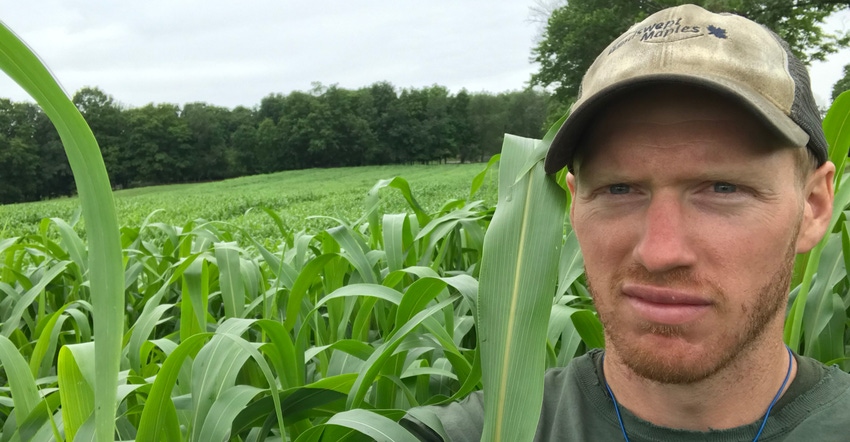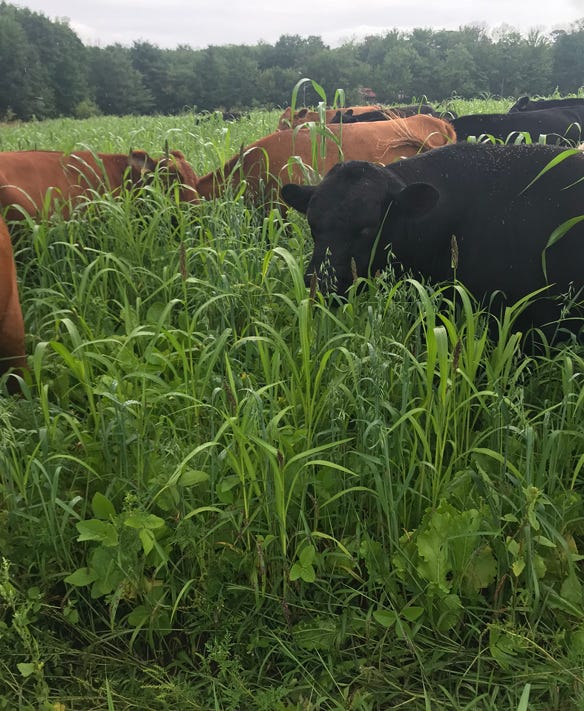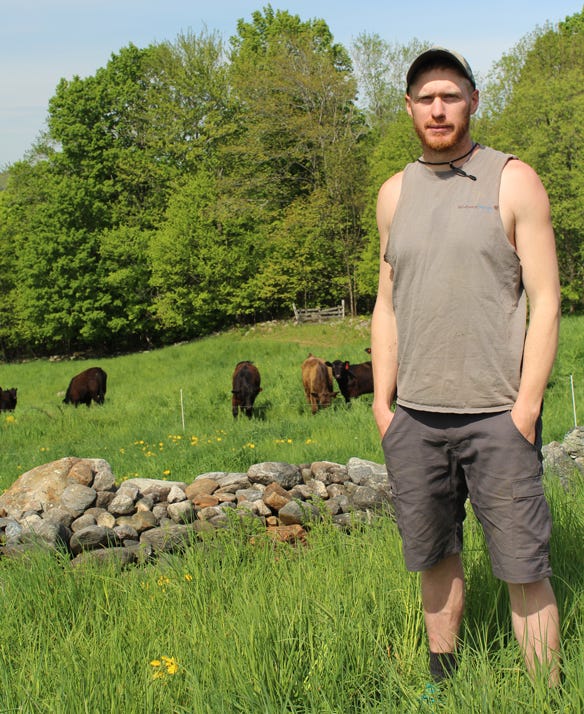June 2, 2021

Jeff Moore juggles a lot of pieces managing feed for his beef herd. At the top of the list is improving and maintaining soil health because, he says, that’s where it all starts.
“I want to do things more conservatively,” he says. “With climate change, I want to make sure I’m building organic matter and better soil.”
Summer annuals like sorghum-sudangrass can help. They furnish a dependable forage in hot summer months while their strong root systems beef up biomass and add organic matter to the soil.
Moore runs Windswept Maples Farm in Loudon, N.H., with his parents, Larry and Melissa Moore, and the help of his two brothers. They’re the eighth generation on a farm that’s been in the family since 1780. Maple is the main business, but the Moores also grow hay, sweet corn and other vegetables for retail.

CATTLE IN THE MIX: Beef from the family’s herd of Angus-cross and Gelbvieh are an important part of the farm’s business.
Beef cattle have always been part of the farm. Larry and Melissa began raising beef commercially in the 1980s, and Jeff took over grazing management in 2010. There’s strong demand for beef from their herd of 28 cow-calf pairs.
The farm grows about 15 acres of corn for silage, depending on the year, and 10 to 15 acres of sorghum-sudangrass. The rest of their cropland is mostly orchardgrass-timothy and sweet corn.
Jeff’s decisions keep the big picture in focus. He’s working out a long-range system of rotational grazing, harvested forage and cover crops that will feed his cattle all year long while also building healthy soil.
One crop, many benefits
He first gave sorghum-sudangrass a try about five years ago.
No-till cultivation was attractive, for one thing. The soils are ledgy and, in addition to the home farm, the family uses land from about 50 different landowners.
“We hate picking rocks, and we have so many landowners, we don’t want to put a lot into the fields,” Jeff says. “We don’t need to do a lot with no-till.” It also keeps moisture in the ground.
Sorghum-sudangrass is an ideal crop for current weather conditions.
“We’ve had really dry summers and could be in worse shape this year than last because we never replenished the aquifers over the winter,” Jeff says. “The climate is going to be hotter and drier, with more intense rainstorms, so it doesn’t make sense to have exposed soil all the time, raising corn.”
He likes the idea of replacing some corn silage and the intensive tillage required with summer annuals. They give him flexibility, too.
“Corn ties you into a long-season crop, which doesn’t work well with cover crops,” Jeff says. “So, sorghum-sudangrass is a way to have a shorter-season crop that can still produce high-volume feed.” (Although it’s a little less digestible than corn, the BMR varieties he grows help make up for that.)

EYE ON GRAZING: There are 60 to 80 acres of grazable land on the home farm, plus another 30 acres to pasture young stock off the farm. Right now, the herd is grazed from May to November, with some bale-grazing. This keeps manure out of the barn and on the land, but there’s not much protection from wind, while the ledgy soils can make for muddy conditions.
For him, sorghum-sudangrass has two big advantages.
“They use one-third less water than corn, so it’s great for drought conditions. And sorghum-sudangrass will grow at up to 105 degrees [F] where corn will stop growing at 85 degrees.”
But sorghum-sudangrass can also be tough to harvest. It grows as tall as 5 feet or more, thick and wet, so drying it is challenging. Jeff cuts at a 3- to 4-foot height, leaving 6 inches of stubble to promote strong regrowth. Some silage goes into round bales, but storing it in bunker silos cuts down on the plastic to be disposed of.
Where Jeff grows sorghum-sudangrass, he grazes a cover crop of winter rye in the spring, then no-tills sorghum-sudangrass once soil temperature reaches about 60 degrees. He cuts it twice for silage, at the end of July and again in mid-September.
Sorghum-sudangrass regrows quickly, but frost will kill it off. There’s plenty of time to establish a good cover crop, which does more than just prevent erosion over the winter: It adds organic matter to the soil.
He also plans to try a single cut of sorghum-sudangrass, then drilling in a cover crop mix. After a month’s growth, he’ll graze it (making sure it’s tall enough to avoid prussic acid poisoning), then plant winter rye or triticale.
A single cut will save harvest costs. Plus, he’ll be able to establish a more diverse cover crop early. The sorghum-sudangrass will continue to grow, providing good grazing when other pastures are slowing, as well as solid winter cover.
Eye on grazing
Jeff keeps in sight the goal of pasturing his herd as much as possible. There are 60 to 80 acres of grazable land on the home farm, plus another 30 acres to pasture young stock off the farm. Right now, the herd is grazed from May to November, with some bale-grazing — feeding round bales in the field.
That keeps manure out of the barn and on the land. But there’s not much protection from wind on the farm, while its ledgy soils can make for muddy conditions.
“At the end of the day, I need to be able to feed my cows through the winter,” Jeff says.
There are a lot of interconnected factors to navigate and to adapt to changing conditions.
“The farm is always in transition,” he says. “We’re always experimenting with what is the best system and how does it fit in. Just trying to find the sweet spot, that’s the difficult thing.”
Harlow writes from Vermont.
About the Author(s)
You May Also Like




